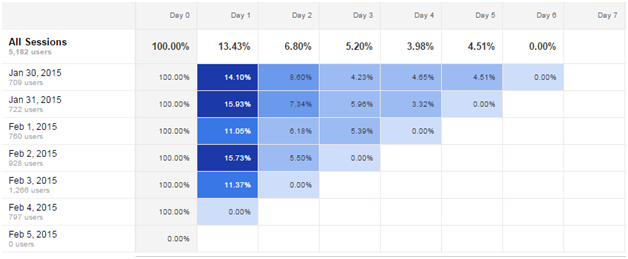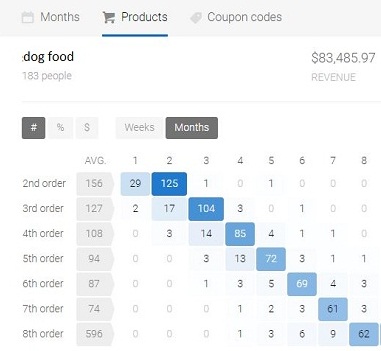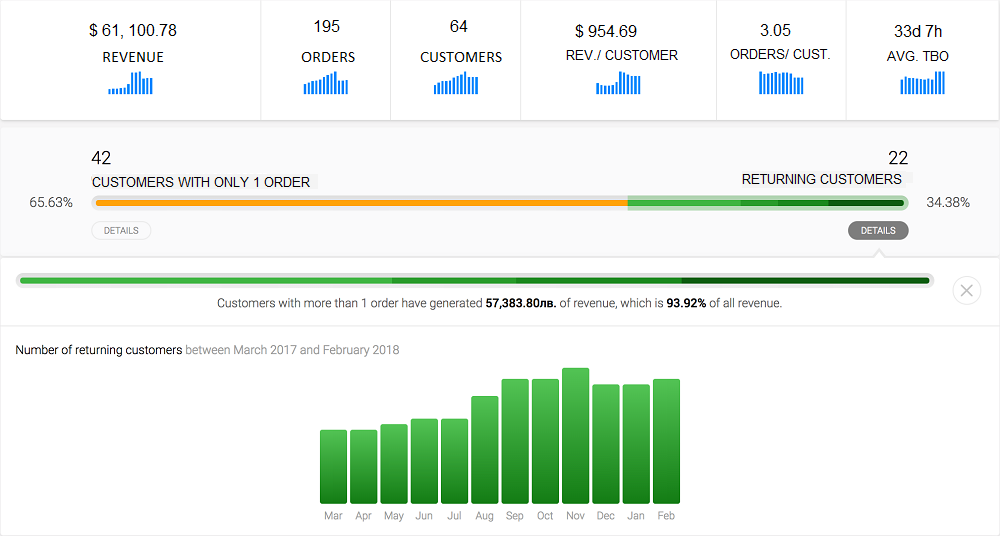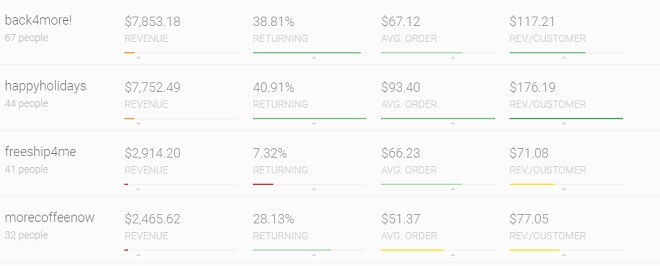
Boost customer retention with cohort analysis
Cohort analysis sounds so complicated and so boring. Isn’t it big-player stuff, one of those reports prepared for board meetings that no-one cares about? Do you need a data geek to do it?
Fortunately, no, no and no.
It’s actually a fun exercise for you as an ecommerce marketer that paves the way for meaningful customer retention marketing. And it doesn’t need to be a pain the a**.
Let’s dive in.
What is cohort analysis in ecommerce?
Ecommerce cohort analysis puts customers into groups by a common trait and then tracks cohort behavior over time: how often they shop in your store, how much they spend, for how long they stay customers.
*Customer cohorts can be defined by the time of conversion, the first product bought, the campaign that converted them, etc. Because they reacted similarly to a product or campaign, it is reasonable to group those people together for future monitoring too.
Ecommerce cohort analysis maps out the entire customer lifecycle from the first order to the last, showing how customer retention unfolds. It usually appears in the form of a cohort matrix.
Thanks to cohort analysis, you can optimize your marketing and offers for higher customer retention in a data-driven way.

How to do cohort analysis?
Since this is a bit of a long-term tracking report, it’s hard to do in an excel sheet, for example. You can:
- set up a report in GA,
- use specific tags in your current CRM and check on the tagged groups regularly, or
- use a cohort analysis tool like Metrilo.
For a proper cohort analysis – even if you do the segmenting and filtering yourself, you’ll need details like:
- Time of first purchase
- Time of all purchases made
- Products bought
- CLV, order values
- Activity other than buying
A good ecommerce CRM will have all the info on customer behavior that you need to understand buying habits and be able to serve them better.
What’s more, it will do the cohort analysis report for you and map out customer behavior over time so you can compare how different cohorts perform.
Related: How online stores boost sales using a CRM
But the coolest thing is the retention matrix, showing when the next orders happen and how customer loyalty unfolds. It’s a goldmine of info when to send emails and how you can stimulate additional orders.
How to read a cohort analysis?
Usually, those reports appear in a matrix shape where you have time in the columns and the name of the cohort or other attribute in the rows.

There’s color coding – darker and lighter hues – that indicates more orders/ sessions/ goal completions happen in a particular period for a particular cohort. You also get numbers/ values/ percentages to compare.
Basically, for ecommerce needs, such a matrix would lay out when people place their next orders after the first.
For some cohorts this can be each month – a healthy rate of repeat orders within the cohort mean it’s a good one and loyal.

How the customer retention matrix looks for products bought monthly, like a subscription.
For other cohorts, the picture can be just a handful of scattered orders here and there, indicating they were not a good fit.
A cohort’s lifespan ends when the last people in it churn. If most of your cohorts churn soon and return rates are low, you have a retention problem.
In the example below you see in which week after the first order people from that cohort place their second, third and so on order. Week 13 is great for 4th orders!

Metrics to look for when doing cohort analysis
- Repeat rate – the share of returning customers vs the one-timers in a cohort.
- Orders per customer – the more repeat buyers you have, the more orders they make each.
- Time between orders – the typical pace at which people shop from you if you want to realistic
- Customer lifetime value (CLV) – measures customer loyalty in money spent.
- Average order value (AOV) – shows differences in the spending habits among cohorts

Cohort analysis vs churn analysis
The two are connected, but not the same thing. Where cohorts die out, churn begins.
Cohort analysis is how customers sharing a common characteristic behave over time. Churn analysis explains why people leave and never shop from you again. The easiest way to find out is asking for feedback.
Increase customer retention rate using cohort analysis
Cohort analysis gives you a deeper understanding of how people buy and what stimulates repeat buying: what products, promotions and marketing initiatives attract loyal customers.
This is qualitative and quantitative data that shows you what works for customer retention so using it will get you more loyal customers and repeat orders.
In short: it’s behavioral data illustrating how well you do customer retention.
Discover retention drivers
Comparing different cohorts, you will see which factors impact retention.
- By month of purchase – see if month-long campaigns, site changes or seasonality (a holiday coming up, new season items, people getting ready for a vacation, etc.) play a role in some months
- By first product bought – how it works on customer satisfaction and next orders
- By coupon used for first order – reveals what kinds of promotions work best with your customers
For example, you might find that your deep discount coupons don’t attract loyal customers but only one-timers. Or that you get lots and lots of holiday shoppers who never come back.
Predict future behavior and get ready to react
While cohort analysis is a long-term and ongoing report, some cohorts can be used as templates for projections. Their behavior can guide you what to expect from the cohort that comes in at the same time next year.
Such cohorts are holiday shoppers (November – December), back to school shoppers, deep discount hunters (winter clearance shoppers) and so on. We especially recommend you plan holiday promotions taking past data into account because gift shoppers are usually outside of your core target group and efforts.
Case in point: One client of ours, a seller of artisan coffee, didn’t think they have much to offer for Valentine’s Day.
But a cohort analysis we did together showed that their sales actually got a boost in early February and lots of customers needed gift wrap. Our client didn’t even expect coffee to be a good Valentine’s Day gift, but turns out – it is.
So since then, every year they carefully plan a good marketing campaign for the holiday.
Related: How to turn holiday shoppers in loyal customers
Non-intrusive marketing makes happy customers
Sometimes less is more. Not emailing too often, but emailing at the right time will get you more conversions.
With ecommerce cohort analysis, you’ll know when the different customers are ready to buy again and when they need a little push. Timing your emails properly means you won’t be annoying but hitting just when it’s needed.
Cohort analysis marketing – how to use the insights
Properly time reactivation emails
With cohort analysis, you’ll know your time between orders (TBO), average customer lifetime, and how the orders are distributed over time. It’s then easy to time your emails for the best possible moment when customers are ready to buy again.
We have a client selling coffee online who was very thrilled to discover with Metrilo’s retention analysis that his time between orders is 23 days instead of 45 as he thought!
When you know people usually buy every 23 days, you can make them buy more often, sending offers every 21 days, for example.
They’re about to be ready to buy again anyway so your offer is well-timed and welcome. At the same time, it speeds up the buying cycle by 2 days, which means more orders every month!
On the other hand, if some people don’t place an order by the 23rd-day mark, you can proactively win them back and avoid losing them with another engaging email. This way, you’ll be urging only the idle customers to buy and not bother and annoy the rest.This all can be done with automated emails firing at the right time.
Time between orders is an eye-opening metric in the cohort analysis – without it, you’d be waiting passively for customers to come back or spamming them at times when they don’t need your product.
Ongoing communication between orders
To keep customers engaged without pushing for orders when the time is not right, you can use content and value-rich emails between orders.
Content is a great way to say more about your products without getting on your customers’ nerves. Here are more ideas for content for ecommerce stores.
Such emails improve the customer experience because the communication is not just sales calls, but people can get something of value for free. They’re more likely to open your emails and generally feel more positive about your brand.
Optimize your product offers
The first order from a store is often a test so customers can judge the quality and service you provide. If they get hooked on the first thing they buy from you and come back again and again, you got a winner – a great product that inspires loyalty.
Make that product a lot more visible (in ads, featured on home page, in content, etc.) so more people buy it and get hooked. More about the Superstar Product Technique here.
This will also help your inventory management because you can discard the products that manage to turn people away, losing them after the first order. They’re more trouble than it’s worth. Why? Most ecom businesses lose money on the first order so only returning buyers actually make you money.
More on revenue vs profit in ecommerce

When doing your cohort analysis by first product ordered, you might find that one category consistently outperforms the others, e.g. your men’s T-shirts get a much more loyal crowd (cohort) than your women’s.
You can act on this insight in two ways:
- Explore why the other part of the audience does not respond so positively (wrong ad copy, unappealing cut and color options, no interest, etc.) and fix it.
- Drop the underperforming line and concentrate on the good one only.
Reward loyalty
If you want to do something special for your loyal buyers, you can simply do it with emails after cohort analysis.
The cohorts that show the greatest engagement can get a secret offer, an extended sale or priority shipping for next orders. The point is, you know who they are and how much they make you so it’s easy to get a good ROI on any special activity.
More: How to engage VIP customers
Reuse successful campaigns
The campaigns that brought in many loyal customers and repeat orders are truly successful. Rinse and repeat them for as many target groups as possible because they bring real profit.
Metrilo’s cohort analysis identifies cohorts by campaign of first order, but you can also use the month of the purchase to relate to the campaign that made the sale.
If you had a month-long initiative with an influencer, for example, it surely did influence your results and direct referred sales are not the only result to look at.
The different kinds of promo offers attract different people and some are a better fit for your business than others.
Percentage off, money value off, new in, special, personalized, win back, abandoned cart promo codes all work for different people and it’s important to find out what gets you repeat sales.
Look at the cohort of each coupon code to see if it works for you long-term (getting returning customers) or only short-term (didn’t get repeat orders).
Personalization at scale
I know it’s hard to keep tabs on each and every customer, but you still want to tailor offers and personal attention.
You can do it after cohort analysis. The cohorts are smaller segments and they share something in common which makes personalization possible and meaningful.
Tailor your communication by what the products bought tell you about the customer and their needs, and offer only related products. The same goes for the promotions that brought them in – if someone converted from a “final sale -70% off” coupon, chances are they need equally deep discounts to continue shopping from you.
On the other hand, a cohort might consist of tens or hundreds of people (depending on your store and products) and that means 1 personalization effort for each cohort, not person.
Control AOV
A cohort analysis shows how spending and AOV change over time.
If you get the same size orders regularly and AOV doesn’t go down, you’re fine. It means repeat sales are stable, you’re not losing those customers and their interest.
If those numbers go bad, though, you can add an incentive to stimulate larger orders: bundles, mix and match offers, free shipping above a certain sum, etc.
What if АOV goes up over time?
This means people test you with their first order and you gradually manage to earn their trust, which leads to larger orders.
Then, you can do something about the first order to put shoppers at ease right away and start off the relationship stronger. Set a free shipping threshold, present yourself and your brand better, add more details about your higher-priced items compared to the lower-priced ones, put more social proof (user-generated content) on your site.
Related: Cohorts, sales, and seasonality – case study
Cohort analysis in ecommerce is a goldmine of data, on which to tailor and improve your marketing. What’s more, cohort retention is easier to start with than 1-on-1 engagement.
Excited to do Cohort Analysis for your online store?
Build and grow your ecommerce brand
Metrilo’s mission is to help you build your ecommerce brand and win your place in the customer’s heart. We share what we learn from our daily work with product innovators and founders here. Subscribe to our weekly newsletter to get the freshest lessons and conquer your niche.
We promise, no spam.
Thank you for subscribing!
See you soon :-)






